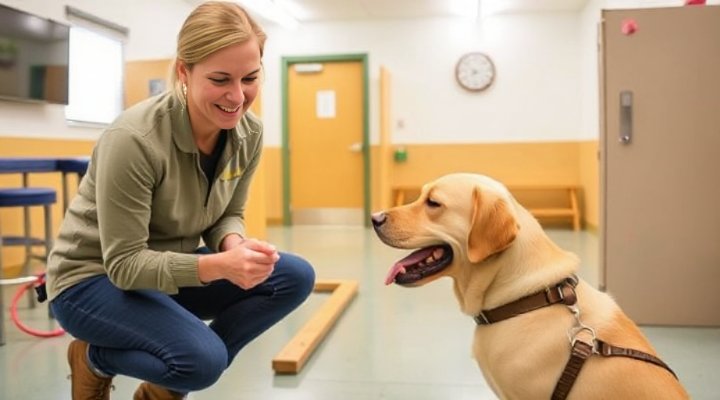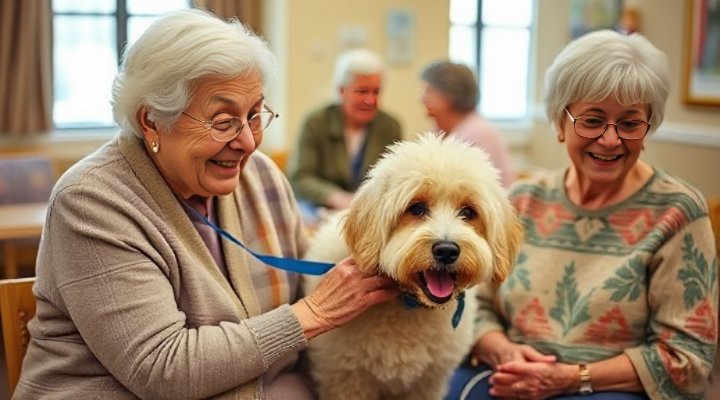Therapy dog training is more than just teaching your pet new tricks—it’s about unlocking their potential to make a real difference in people’s lives. Whether it’s comforting patients in hospitals or providing emotional support in schools, therapy dogs bring immeasurable joy and relief. In this article, we’ll explore how therapy dog training can transform both your life and your pet’s, step by step.

The Benefits of Therapy Dog Training
First and foremost, therapy dog training offers numerous benefits for both the dog and the handler. For instance, it strengthens the bond between you and your pet while providing a sense of purpose. Moreover, therapy dogs often exhibit improved behavior and socialization skills, making them happier and more well-adjusted companions.
On the other hand, the impact on the people they help is profound. Studies show that interactions with therapy dogs can reduce stress, lower blood pressure, and even alleviate symptoms of depression. Above all, these dogs bring comfort to those who need it most, from children in hospitals to seniors in nursing homes.

How to Get Started with Therapy Dog Training
If you’re considering therapy dog training for your pet, the first step is to ensure they have the right temperament. Most importantly, therapy dogs should be calm, friendly, and adaptable to new environments. Additionally, basic obedience training is a must—your dog should reliably respond to commands like ‘sit,’ ‘stay,’ and ‘leave it.’
Next, you’ll want to enroll in a specialized therapy dog training program. Many organizations, such as Therapy Dogs International, offer certification courses that prepare dogs for real-world scenarios. During these sessions, your dog will learn how to remain calm around medical equipment, navigate crowded spaces, and interact gently with people of all ages.

The Certification Process for Therapy Dogs
Once your dog has completed their training, the next step is certification. This typically involves an evaluation by a certified tester who assesses your dog’s behavior and skills. For example, your dog may need to demonstrate how they react to sudden noises or unfamiliar touches. Likewise, they’ll be tested on their ability to remain focused and calm in distracting environments.
After passing the evaluation, your dog will receive official certification, allowing them to visit hospitals, schools, and other facilities. Keep in mind that certification requirements may vary depending on the organization, so it’s essential to research your options beforehand. For more details, check out our guide to therapy animal certification.

Real-Life Stories: The Impact of Therapy Dogs
To truly understand the power of therapy dog training, let’s look at some real-life examples. Take Bella, a Golden Retriever who visits a local children’s hospital weekly. Her presence alone brings smiles to young patients undergoing treatment. Similarly, Max, a certified therapy dog, helps students at an elementary school by providing comfort during stressful exam periods.
These stories highlight how therapy dogs can transform lives in unexpected ways. Not only do they offer emotional support, but they also create moments of joy and connection in challenging situations. If you’re curious about other inspiring tales, our article on training your pet to become a certified therapy dog shares more heartwarming experiences.

Conclusion: A Rewarding Journey for You and Your Pet
In conclusion, therapy dog training is a rewarding journey that benefits both you and your pet. From enhancing your dog’s skills to making a positive impact on others, the possibilities are endless. Whether you’re just starting or ready to take the next step, remember that patience and consistency are key.
If you’re eager to learn more about dog training, explore our dog obedience training guide or discover how agility training can further boost your pet’s confidence. Above all, enjoy the process and celebrate every milestone with your furry friend!
Related Keywords: therapy dog certification, emotional support dog training, dog training programs, pet therapy benefits, therapy dog requirements
